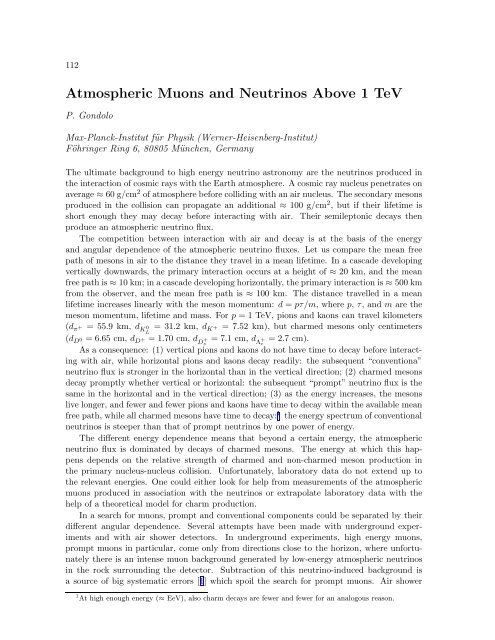Proc. Neutrino Astrophysics - MPP Theory Group
Proc. Neutrino Astrophysics - MPP Theory Group
Proc. Neutrino Astrophysics - MPP Theory Group
Create successful ePaper yourself
Turn your PDF publications into a flip-book with our unique Google optimized e-Paper software.
112<br />
Atmospheric Muons and <strong>Neutrino</strong>s Above 1 TeV<br />
P. Gondolo<br />
Max-Planck-Institut für Physik (Werner-Heisenberg-Institut)<br />
Föhringer Ring 6, 80805 München, Germany<br />
The ultimate background to high energy neutrino astronomy are the neutrinos produced in<br />
the interaction of cosmic rays with the Earth atmosphere. A cosmic ray nucleus penetrates on<br />
average ≈ 60 g/cm 2 of atmosphere before colliding with an air nucleus. The secondary mesons<br />
produced in the collision can propagate an additional ≈ 100 g/cm 2 , but if their lifetime is<br />
short enough they may decay before interacting with air. Their semileptonic decays then<br />
produce an atmospheric neutrino flux.<br />
The competition between interaction with air and decay is at the basis of the energy<br />
and angular dependence of the atmospheric neutrino fluxes. Let us compare the mean free<br />
path of mesons in air to the distance they travel in a mean lifetime. In a cascade developing<br />
vertically downwards, the primary interaction occurs at a height of ≈ 20 km, and the mean<br />
free path is ≈ 10 km; in a cascade developing horizontally, the primary interaction is ≈ 500 km<br />
from the observer, and the mean free path is ≈ 100 km. The distance travelled in a mean<br />
lifetime increases linearly with the meson momentum: d = pτ/m, where p, τ, and m are the<br />
meson momentum, lifetime and mass. For p = 1 TeV, pions and kaons can travel kilometers<br />
(d π + = 55.9 km, d K 0 L = 31.2 km, d K + = 7.52 km), but charmed mesons only centimeters<br />
(d D 0 = 6.65 cm, d D + = 1.70 cm, d D + s = 7.1 cm, d Λ + c = 2.7 cm).<br />
As a consequence: (1) vertical pions and kaons do not have time to decay before interacting<br />
with air, while horizontal pions and kaons decay readily: the subsequent “conventiona”<br />
neutrino flux is stronger in the horizontal than in the vertical direction; (2) charmed mesons<br />
decay promptly whether vertical or horizontal: the subsequent “prompt” neutrino flux is the<br />
same in the horizontal and in the vertical direction; (3) as the energy increases, the mesons<br />
live longer, and fewer and fewer pions and kaons have time to decay within the available mean<br />
free path, while all charmed mesons have time to decay: 1 the energy spectrum of conventional<br />
neutrinos is steeper than that of prompt neutrinos by one power of energy.<br />
The different energy dependence means that beyond a certain energy, the atmospheric<br />
neutrino flux is dominated by decays of charmed mesons. The energy at which this happens<br />
depends on the relative strength of charmed and non-charmed meson production in<br />
the primary nucleus-nucleus collision. Unfortunately, laboratory data do not extend up to<br />
the relevant energies. One could either look for help from measurements of the atmospheric<br />
muons produced in association with the neutrinos or extrapolate laboratory data with the<br />
help of a theoretical model for charm production.<br />
In a search for muons, prompt and conventional components could be separated by their<br />
different angular dependence. Several attempts have been made with underground experiments<br />
and with air shower detectors. In underground experiments, high energy muons,<br />
prompt muons in particular, come only from directions close to the horizon, where unfortunately<br />
there is an intense muon background generated by low-energy atmospheric neutrinos<br />
in the rock surrounding the detector. Subtraction of this neutrino-induced background is<br />
a source of big systematic errors [1] which spoil the search for prompt muons. Air shower<br />
1 At high enough energy (≈ EeV), also charm decays are fewer and fewer for an analogous reason.













